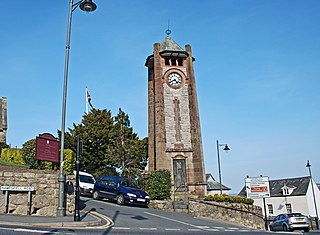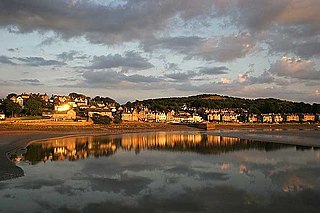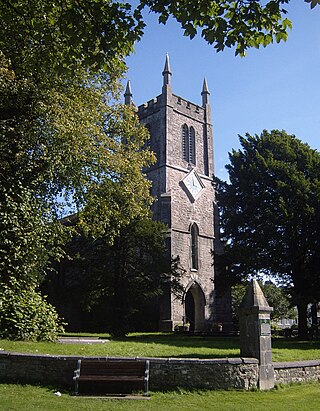
Grange-over-Sands is a town and civil parish located on the north side of Morecambe Bay in Cumbria, England, a few miles south of the Lake District National Park. In the 2001 census the parish had a population of 4,042, increasing at the 2011 census to 4,114. Historically part of Lancashire, the town was created as an urban district in 1894. Since the 1974 local government re-organisation, it has been of the South Lakeland district of Cumbria, though it remains part of the Duchy of Lancaster.

Milnthorpe is a small market town on the southern border of Cumbria, 7 miles south of Kendal, civil parish and electoral ward are in the South Lakeland district of Cumbria, England. Historically in the county of Westmorland and on the A6, the town contains several old hostelries and hosts a market every Friday. The parish, which includes the small village of Ackenthwaite, had a population of 2,199 according to the 2011 Census.

Arnside is a village and civil parish in Cumbria, historically part of Westmorland, near the border with Lancashire, England. The Lake District National Park is located a few miles North. Travelling by road, Arnside is 22 miles (35 km) to the south of Kendal, 25.3 miles (40.7 km) to the east of Ulverston, 35.2 miles (56.6 km) to the east of Barrow-in-Furness, 15.7 miles (25.3 km) to the west of Lancaster and 14.3 miles (23.0 km) to the east of Grange-over-Sands. In the 2001 census the parish had a population of 2,301, increasing at the 2011 census to 2,334.

Kents Bank is a small village in Cumbria, England, so named for its proximity to the River Kent estuary. Part of the historic County Palatine of Lancashire, it is located 2 miles (3.2 km) south-west of Grange-over-Sands.

Beetham is a village and civil parish in the South Lakeland district, in Cumbria, England, situated on the border with Lancashire, 6 miles (10 km) north of Carnforth. It is part of the Arnside and Silverdale Area of Outstanding Natural Beauty. In the 2001 census the parish had a population of 1,724, increasing at the 2011 census to 1,784.

Levens Hall is a manor house in the Kent valley, near the village of Levens and 5 miles (9 km) south of Kendal in Cumbria, Northern England.

Holme is a village and civil parish in the South Lakeland district of Cumbria, England, about 2 miles (3.2 km) north of Burton-in-Kendal and 3 miles (4.8 km) south east of Milnthorpe. The parish had a population of 1,167 at the 2001 census, increasing to 1,486 at the 2011 Census.

The River Bela is a short river in the county of Cumbria, England. It is in the ancient county of Westmorland.

Allithwaite is a small village in Cumbria, England, located roughly 1.2 miles (1.9 km) west of Grange-over-Sands. Most of its residents commute to local areas of Ulverston, Barrow-in-Furness, Kendal or Lancaster to work. Historically in Lancashire, Allithwaite, and the village of Cartmel situated to the north, are part of the civil parish of Lower Allithwaite. At the 2001 census, the parish had a population of 1,758, increasing to 1,831 at the 2011 Census. There is also a civil parish previously known as Upper Allithwaite which was renamed in 2018 as Lindale and Newton-in-Cartmel, and includes Lindale, Low Newton and High Newton. The population of this parish at the 2011 Census was 843.
Westmorland in North West England was abolished in 1974 following Ted Heath's Local Government Act 1972. Westmorland became a part of Cumbria along with Cumberland, parts of Yorkshire and Lancashire, including the Furness peninsular. In 2022 Westmorland was reconstituted as Westmorland and Furness following the abolition of Cumbria County Council. Westmorland and Furness have no High Sheriff as Cumbria has remained the ceremonial county.

Farleton is a village and former civil parish, now in the parish of Beetham, in the South Lakeland local government district, Cumbria, England. In 1931 the parish had a population of 67.
George Webster was an English architect who practised in Kendal, which was at the time in Westmorland, and later in Cumbria. All of his works were executed near his practice, and were located in Cumbria, in north Lancashire, and in the adjacent parts of Yorkshire. Most of his work was carried out on domestic buildings, but he also designed churches, and public and commercial buildings.

Daniel Wilson of Dallam Tower, Westmorland was a British Whig politician who sat in the House of Commons for a total of 34 years between 1708 and 1747.

St Michael's Church is in the village of Beetham, Cumbria, England. It is an active Anglican parish church in the deanery of Kendal, the archdeaconry of Westmoreland and Furness, and the diocese of Carlisle. The church is recorded in the National Heritage List for England as a designated Grade I listed building.

St James' Church is in the village of Arnside, Cumbria, England. It is an active Anglican parish church in the deanery of Kendal, the archdeaconry of Westmorland and Furness, and the diocese of Carlisle.
Edward Wilson of Dallam Tower was member of the Parliament of Great Britain for Westmorland from 1747 to 1754, being returned unopposed, and was an unsuccessful candidate for the same seat in 1761. He succeeded his father Daniel Wilson (1680–1754) in the seat.

St Thomas' Church is in the village of Milnthorpe, Cumbria, England. It is an active Anglican parish church in the deanery of Kendal, the archdeaconry of Westmorland and Furness, and the diocese of Carlisle.

Dalemain is a country house around 5 miles south-west of Penrith in Cumbria, England. It is a Grade I listed building. Dalemain is part of the Lake District UNESCO World Heritage Site.

Sandside is a hamlet near Storth in Beetham parish, South Lakeland, Cumbria, England. Historically in Westmorland, it lies on the south shore of the estuary of the River Kent, between Arnside and Milnthorpe. There is one pub, The Ship, which is believed to date from 1671, one restaurant, The Kingfisher, under current ownership since 1999, and several commercial businesses.
Beetham is a civil parish in the South Lakeland District of Cumbria, England. It contains 47 listed buildings that are recorded in the National Heritage List for England. Of these, four are listed at Grade I, the highest of the three grades, four are at Grade II*, the middle grade, and the others are at Grade II, the lowest grade. The parish contains the villages of Beetham, Farleton and Hazelslack, and the surrounding countryside. The Lancaster Canal passes through the parish, and the listed buildings associated with this are bridges, an aqueduct and a milestone. Most of the listed buildings in the parish are houses, some of them originally tower houses, and associated structures, farmhouses and farm buildings. The other listed buildings consist of a church, bridges, a former corn mill, milestones and a milepost, boundary stones and a boundary post, a former school, a signal box, and a war memorial.

















